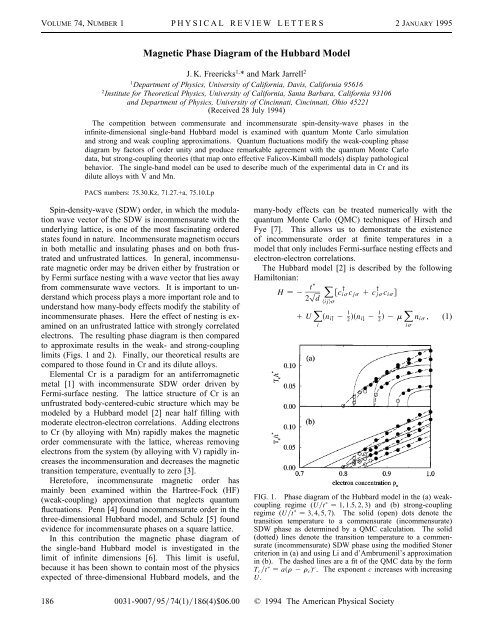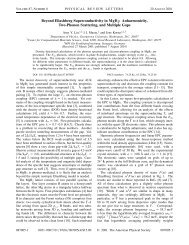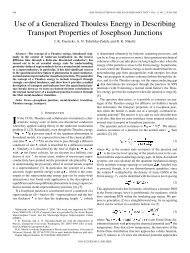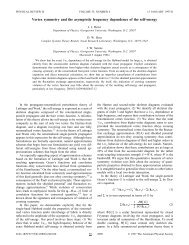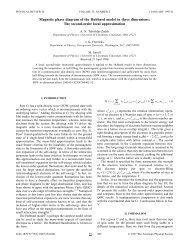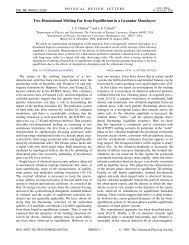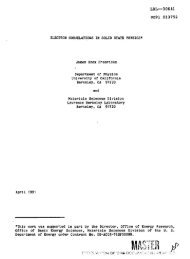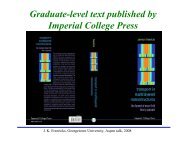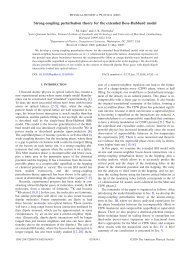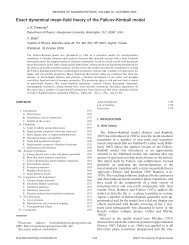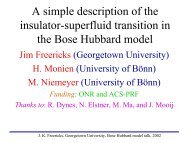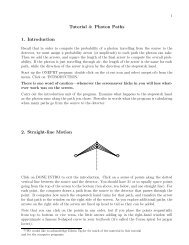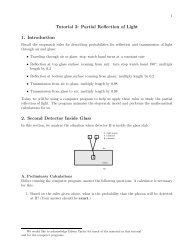Magnetic Phase Diagram of the Hubbard Model - Physics ...
Magnetic Phase Diagram of the Hubbard Model - Physics ...
Magnetic Phase Diagram of the Hubbard Model - Physics ...
Create successful ePaper yourself
Turn your PDF publications into a flip-book with our unique Google optimized e-Paper software.
VOLUME 74, NUMBER 1 PHYSICAL REVIEW LETTERS 2JANUARY 1995<br />
<strong>Magnetic</strong> <strong>Phase</strong> <strong>Diagram</strong> <strong>of</strong> <strong>the</strong> <strong>Hubbard</strong> <strong>Model</strong><br />
J. K. Freericks 1, * and Mark Jarrell 2<br />
1<br />
Department <strong>of</strong> <strong>Physics</strong>, University <strong>of</strong> California, Davis, California 95616<br />
2<br />
Institute for Theoretical <strong>Physics</strong>, University <strong>of</strong> California, Santa Barbara, California 93106<br />
and Department <strong>of</strong> <strong>Physics</strong>, University <strong>of</strong> Cincinnati, Cincinnati, Ohio 45221<br />
(Received 28 July 1994)<br />
The competition between commensurate and incommensurate spin-density-wave phases in <strong>the</strong><br />
infinite-dimensional single-band <strong>Hubbard</strong> model is examined with quantum Monte Carlo simulation<br />
and strong and weak coupling approximations. Quantum fluctuations modify <strong>the</strong> weak-coupling phase<br />
diagram by factors <strong>of</strong> order unity and produce remarkable agreement with <strong>the</strong> quantum Monte Carlo<br />
data, but strong-coupling <strong>the</strong>ories (that map onto effective Falicov-Kimball models) display pathological<br />
behavior. The single-band model can be used to describe much <strong>of</strong> <strong>the</strong> experimental data in Cr and its<br />
dilute alloys with V and Mn.<br />
PACS numbers: 75.30.Kz, 71.27.+a, 75.10.Lp<br />
Spin-density-wave (SDW) order, in which <strong>the</strong> modulation<br />
wave vector <strong>of</strong> <strong>the</strong> SDW is incommensurate with <strong>the</strong><br />
underlying lattice, is one <strong>of</strong> <strong>the</strong> most fascinating ordered<br />
states found in nature. Incommensurate magnetism occurs<br />
in both metallic and insulating phases and on both frustrated<br />
and unfrustrated lattices. In general, incommensurate<br />
magnetic order may be driven ei<strong>the</strong>r by frustration or<br />
by Fermi surface nesting with a wave vector that lies away<br />
from commensurate wave vectors. It is important to understand<br />
which process plays a more important role and to<br />
understand how many-body effects modify <strong>the</strong> stability <strong>of</strong><br />
incommensurate phases. Here <strong>the</strong> effect <strong>of</strong> nesting is examined<br />
on an unfrustrated lattice with strongly correlated<br />
electrons. The resulting phase diagram is <strong>the</strong>n compared<br />
to approximate results in <strong>the</strong> weak- and strong-coupling<br />
limits (Figs. 1 and 2). Finally, our <strong>the</strong>oretical results are<br />
compared to those found in Cr and its dilute alloys.<br />
Elemental Cr is a paradigm for an antiferromagnetic<br />
metal [1] with incommensurate SDW order driven by<br />
Fermi-surface nesting. The lattice structure <strong>of</strong> Cr is an<br />
unfrustrated body-centered-cubic structure which may be<br />
modeled by a <strong>Hubbard</strong> model [2] near half filling with<br />
moderate electron-electron correlations. Adding electrons<br />
to Cr (by alloying with Mn) rapidly makes <strong>the</strong> magnetic<br />
order commensurate with <strong>the</strong> lattice, whereas removing<br />
electrons from <strong>the</strong> system (by alloying with V) rapidly increases<br />
<strong>the</strong> incommensuration and decreases <strong>the</strong> magnetic<br />
transition temperature, eventually to zero [3].<br />
Heret<strong>of</strong>ore, incommensurate magnetic order has<br />
mainly been examined within <strong>the</strong> Hartree-Fock (HF)<br />
(weak-coupling) approximation that neglects quantum<br />
fluctuations. Penn [4] found incommensurate order in <strong>the</strong><br />
three-dimensional <strong>Hubbard</strong> model, and Schulz [5] found<br />
evidence for incommensurate phases on a square lattice.<br />
In this contribution <strong>the</strong> magnetic phase diagram <strong>of</strong><br />
<strong>the</strong> single-band <strong>Hubbard</strong> model is investigated in <strong>the</strong><br />
limit <strong>of</strong> infinite dimensions [6]. This limit is useful,<br />
because it has been shown to contain most <strong>of</strong> <strong>the</strong> physics<br />
expected <strong>of</strong> three-dimensional <strong>Hubbard</strong> models, and <strong>the</strong><br />
many-body effects can be treated numerically with <strong>the</strong><br />
quantum Monte Carlo (QMC) techniques <strong>of</strong> Hirsch and<br />
Fye [7]. This allows us to demonstrate <strong>the</strong> existence<br />
<strong>of</strong> incommensurate order at finite temperatures in a<br />
model that only includes Fermi-surface nesting effects and<br />
electron-electron correlations.<br />
The <strong>Hubbard</strong> model [2] is described by <strong>the</strong> following<br />
Hamiltonian:<br />
H 2<br />
t<br />
2 p X<br />
cisc y js 1 cjsc y is <br />
d<br />
ijs<br />
X<br />
1 U n i" 2 1 2 n i# 2 1 2 2m X<br />
n is , (1)<br />
i<br />
FIG. 1. <strong>Phase</strong> diagram <strong>of</strong> <strong>the</strong> <strong>Hubbard</strong> model in <strong>the</strong> (a) weakcoupling<br />
regime (Ut 1, 1.5, 2, 3) and (b) strong-coupling<br />
regime (Ut 3, 4, 5, 7). The solid (open) dots denote <strong>the</strong><br />
transition temperature to a commensurate (incommensurate)<br />
SDW phase as determined by a QMC calculation. The solid<br />
(dotted) lines denote <strong>the</strong> transition temperature to a commensurate<br />
(incommensurate) SDW phase using <strong>the</strong> modified Stoner<br />
criterion in (a) and using Li and d’Ambrumenil’s approximation<br />
in (b). The dashed lines are a fit <strong>of</strong> <strong>the</strong> QMC data by <strong>the</strong> form<br />
T c t ar 2r c c . The exponent c increases with increasing<br />
U.<br />
is<br />
186 0031-90079574(1)186(4)$06.00 © 1994 The American Physical Society
VOLUME 74, NUMBER 1 PHYSICAL REVIEW LETTERS 2JANUARY 1995<br />
FIG. 2. <strong>Phase</strong> diagram for <strong>the</strong> <strong>Hubbard</strong> model as a function<br />
<strong>of</strong> electron concentration and U. The thin (thick) solid<br />
lines denote <strong>the</strong> commensurate-incommensurate phase boundary<br />
for <strong>the</strong> Stoner criterion (modified Stoner criterion); <strong>the</strong><br />
thin (thick) dashed lines are <strong>the</strong> corresponding results for <strong>the</strong><br />
incommensurate-paramagnetic phase boundary. The dotted line<br />
is <strong>the</strong> strong-coupling approximation for <strong>the</strong> commensurateparamagnetic<br />
phase boundary. The solid (open) dots denote<br />
<strong>the</strong> QMC solutions that display commensurate (incommensurate)<br />
SDW order.<br />
where c y i (c i ) is a creation (destruction) operator for<br />
an electron at site i with spin s. The hopping matrix<br />
elements connect nearest neighbors on a hypercubic<br />
lattice in d dimensions; its magnitude is written as<br />
t t 2 p d [to have a well-defined limit in infinite<br />
dimensions (d ! `)]. All energies are expressed in units<br />
<strong>of</strong> <strong>the</strong> rescaled hopping matrix element t . The Coulomb<br />
repulsion is represented by U and <strong>the</strong> chemical potential<br />
by m.<br />
In <strong>the</strong> limit <strong>of</strong> infinite dimensions <strong>the</strong> local approximation<br />
becomes exact [6]. The electronic Green’s function<br />
Giv n G n is represented by an integral over <strong>the</strong> noninteracting<br />
density <strong>of</strong> states ry exp2y 2 p p:<br />
Z `<br />
G n <br />
r y<br />
dy<br />
2` iv n 2m2S n 2y<br />
F`iv n 1m2S n , (2)<br />
with S n Siv n <strong>the</strong> electronic self-energy. The magnetic<br />
susceptibility satisfies Dyson’s equation,<br />
x mn q xmqd 0 mn 2 T X xmqG 0 mr x rn q , (3)<br />
r<br />
with G mr Giv m , iv r <strong>the</strong> local irreducible vertex function<br />
for SDW order. The bare particle-hole susceptibility<br />
xmq 0 is defined by<br />
xm 0 q 2TX G m kG m k1q<br />
k<br />
2p 1 1<br />
Z `<br />
p dy<br />
p 12X<br />
2<br />
2`<br />
e 2y2<br />
3<br />
iv n 2m2S n 2y F`<br />
∑ ∏<br />
ivn 1m2S n 2Xy<br />
3 p . (4)<br />
1 2 X<br />
2<br />
The bare susceptibility only depends on <strong>the</strong> scalar parameter<br />
Xq P d<br />
i1cos q i d, which defines an equivalence<br />
class <strong>of</strong> wave vectors in <strong>the</strong> infinite-dimensional Brillouin<br />
zone [8]. Xq can be parametrized by <strong>the</strong> line that<br />
extends along <strong>the</strong> Brillouin zone diagonal from <strong>the</strong><br />
zone center (X 1) to <strong>the</strong> zone corner X 21. The<br />
self-energy and irreducible vertex function are extracted<br />
from <strong>the</strong> self-consistent QMC simulations as described<br />
previously [9].<br />
It is important to qualify <strong>the</strong> region <strong>of</strong> validity <strong>of</strong><br />
different approximation techniques by comparing <strong>the</strong>m<br />
with <strong>the</strong> numerically exact QMC results (<strong>the</strong> errors <strong>of</strong> <strong>the</strong><br />
QMC calculation are well understood and controllable).<br />
In <strong>the</strong> weak-coupling limit a renormalized Hartree-Fock<br />
approach [10] is employed.<br />
determined by <strong>the</strong> Stoner criterion,<br />
1<br />
U x0 ph X, T TX n<br />
The Néel temperature is<br />
xn 0 X, (5)<br />
where <strong>the</strong> bare particle-hole susceptibility xn 0 X is calculated<br />
with noninteracting Green’s functions Gn 0 [S n 0<br />
in Eq. (2)]. This HF transition temperature is reduced by<br />
factors <strong>of</strong> order 3 due to quantum fluctuations [10], even<br />
in <strong>the</strong> limit Ut ! 0. Quantum fluctuations modify <strong>the</strong><br />
Stoner criterion (by subtracting <strong>the</strong> local particle-particle<br />
susceptibility) to [11]<br />
1<br />
U x0 ph X, T 2x0 ppX 0, T<br />
X<br />
x 0 X, T 2 T jGn 0 j2 , (6)<br />
in <strong>the</strong> limit Ut ! 0. These fluctuations initially reduce<br />
T c by <strong>the</strong> factor exp2xpp 0 0, T crm in <strong>the</strong> weakcoupling<br />
limit [10,11].<br />
In <strong>the</strong> strong-coupling limit <strong>the</strong> <strong>Hubbard</strong> model can<br />
be mapped onto a Falicov-Kimball model [12,13]. This<br />
mapping is exact for <strong>the</strong> self-energy, but not for <strong>the</strong><br />
irreducible vertex functions in <strong>the</strong> limit Ut ! `. As<br />
a result, <strong>the</strong> strong-coupling <strong>the</strong>ories display pathological<br />
behaviors. More explicitly, <strong>the</strong>se approximations assume<br />
that <strong>the</strong> down-spin particles form a static background<br />
when <strong>the</strong> up-spin particles move and vice versa; this<br />
system is <strong>the</strong>n described by Falicov-Kimball models [14]<br />
for both <strong>the</strong> spin-up and spin-down electrons that are selfconsistently<br />
coupled toge<strong>the</strong>r. Two different coupling<br />
schemes have been proposed so far [12,13]. Janiš and<br />
Vollhardt’s approximation [12] underestimates <strong>the</strong> SDW<br />
susceptibility at half filling which strongly suppresses T c<br />
and does not reproduce <strong>the</strong> Heisenberg limit <strong>of</strong> T c <br />
t 2 2U. Li and d’Ambrumenil’s approximation [13] is<br />
correct for large U at half filling, but has <strong>the</strong> pathological<br />
behavior <strong>of</strong> predicting ferromagnetism away from half<br />
filling because <strong>of</strong> segregation in <strong>the</strong> effective Falicov-<br />
Kimball model. This latter pathology occurs because <strong>the</strong><br />
zero temperature occupation number <strong>of</strong> <strong>the</strong> static particles<br />
is 0, 0.5, or1, and segregation occurs whenever <strong>the</strong> static<br />
particle concentration is 0.5 and does not equal <strong>the</strong> mobile<br />
particle concentration [15]. We deal with this pathology,<br />
by only considering ordered states with X , 0.<br />
n<br />
187
VOLUME 74, NUMBER 1 PHYSICAL REVIEW LETTERS 2JANUARY 1995<br />
FIG. 3. The magnetic susceptibility for all Xq at various<br />
temperatures when U 4 and r e 0.825. The susceptibility<br />
displays a peak at X 20.90. As shown in <strong>the</strong> inset,<br />
<strong>the</strong> transition temperature (T c 0.0148t ) was inferred from<br />
extrapolation <strong>of</strong> <strong>the</strong> peak inverse susceptibility.<br />
To determine <strong>the</strong> magnetic transition temperatures, we<br />
calculated <strong>the</strong> magnetic susceptibility for all Xq in <strong>the</strong><br />
Brillouin zone. As shown in Fig. 3, <strong>the</strong> susceptibility always<br />
displayed a maximum at a distinct value <strong>of</strong> X. The<br />
transition temperature was <strong>the</strong>n inferred from interpolation<br />
(or extrapolation) <strong>of</strong> <strong>the</strong> peak inverse susceptibility,<br />
as shown in <strong>the</strong> inset to Fig. 3. At half filling [9] <strong>the</strong><br />
<strong>Hubbard</strong> model in infinite dimensions has a transition to<br />
a commensurate antiferromagnetic state (X 21) at <strong>the</strong><br />
Néel temperature T N . As <strong>the</strong> system is doped away from<br />
half filling, <strong>the</strong> Néel temperature drops until a critical filling<br />
is reached where <strong>the</strong> commensurate SDW becomes<br />
incommensurate. This is shown in Figs. 1(a) and 1(b)<br />
for <strong>the</strong> weak-coupling and strong-coupling results, respectively.<br />
As <strong>the</strong> system is doped fur<strong>the</strong>r away from half<br />
filling, <strong>the</strong> wave vector <strong>of</strong> <strong>the</strong> ordered phase changes continuously<br />
with <strong>the</strong> electron concentration until T c drops to<br />
zero at <strong>the</strong> incommensurate-paramagnetic phase boundary.<br />
The shape <strong>of</strong> <strong>the</strong> magnetic phase boundary changes<br />
continuously from a square-root-like dependence (as a<br />
function <strong>of</strong> doping) at weak coupling to an almost linear<br />
dependence at strong coupling, with <strong>the</strong> same crossover<br />
region U 3t as found for T N at half filling.<br />
<strong>Phase</strong> diagrams in <strong>the</strong> weak-coupling regime (Ut #<br />
3 have been obtained from both QMC simulations and<br />
from <strong>the</strong> <strong>the</strong>ory <strong>of</strong> Eq. (6). They are plotted in Fig. 1(a)<br />
for four values <strong>of</strong> Ut (Ut 1, 1.5, 2, 3). Let X max<br />
denote <strong>the</strong> largest value <strong>of</strong> <strong>the</strong> scalar parameter X with<br />
which incommensurate order is found for each value <strong>of</strong><br />
U. In <strong>the</strong> QMC simulations, we find that both X max<br />
increases, and that <strong>the</strong> ratio <strong>of</strong> <strong>the</strong> transition temperature<br />
at <strong>the</strong> commensurate-incommensurate phase boundary T I<br />
to <strong>the</strong> Néel temperature at half filling T N decreases, as <strong>the</strong><br />
coupling strength increases. However, when <strong>the</strong> modified<br />
Stoner criterion is used, we find that <strong>the</strong> transition<br />
temperature curves scale with <strong>the</strong> coupling strength and<br />
maintain <strong>the</strong> same approximate shape. This implies that<br />
X max will increase, while <strong>the</strong> ratio T I T N remains constant,<br />
T I T N 0.57.<br />
188<br />
QMC results in <strong>the</strong> strong-coupling regime Ut $ 3,<br />
along with Li and d’Ambrumenil’s approximation for T c<br />
are plotted in Fig. 1(b) for Ut 3, 4, 5, 7. The approximate<br />
results are generated with <strong>the</strong> restriction that only ordered<br />
states with X , 0 are considered (which suppresses<br />
<strong>the</strong> ferromagnetism due to phase separation). Under<br />
this assumption, <strong>the</strong> strong-coupling <strong>the</strong>ory predicts no<br />
incommensurate order (near X 21), and <strong>the</strong> transition<br />
temperature curves also maintain <strong>the</strong> same shape as <strong>the</strong><br />
coupling strength changes. Accurate simulations at very<br />
large values <strong>of</strong> U are not possible with <strong>the</strong> QMC. Thus,<br />
we are unable to determine whe<strong>the</strong>r X max continues to increase<br />
in <strong>the</strong> strong-coupling regime, nor are we able to<br />
determine what happens to T I T N .<br />
Both weak- and strong-coupling approximations are<br />
unable to reproduce <strong>the</strong> qualitative change in shape <strong>of</strong> <strong>the</strong><br />
finite-temperature phase diagrams as a function <strong>of</strong> U.<br />
The “phase diagram” which indicates <strong>the</strong><br />
commensurate-incommensurate phase boundary (occurring<br />
at T T I ) and <strong>the</strong> incommensurate-paramagnetic<br />
phase boundary (occurring at T 0) is presented<br />
in Fig. 2. The thin (thick) solid lines denote <strong>the</strong><br />
commensurate-incommensurate boundary for <strong>the</strong> Stoner<br />
(modified Stoner) criterion; <strong>the</strong> thin (thick) dashed lines<br />
plot <strong>the</strong> corresponding paramagnetic phase boundary.<br />
The dotted line is <strong>the</strong> commensurate-paramagnetic phase<br />
boundary in <strong>the</strong> strong-coupling <strong>the</strong>ory, and <strong>the</strong> dots are<br />
<strong>the</strong> QMC results. The quantum fluctuations strongly<br />
renormalize <strong>the</strong> HF phase boundary to produce good<br />
agreement with <strong>the</strong> QMC [<strong>the</strong> critical value <strong>of</strong> U is<br />
shifted by 1U 1U HF 2xpp0, 0 T c ]. The value <strong>of</strong><br />
X max 20.7 occurs at U ` when <strong>the</strong> modified Stoner<br />
criterion is used, whereas X max increases to <strong>the</strong> ferromagnetic<br />
point X 1 in <strong>the</strong> Stoner <strong>the</strong>ory, i.e., quantum<br />
fluctuations completely suppress ferromagnetism in this<br />
approximation.<br />
Finally, we comment on <strong>the</strong> possibility <strong>of</strong> phase separation.<br />
Recent analysis <strong>of</strong> <strong>the</strong> U ! 0 limit at T 0 has<br />
shown that phase separation between <strong>the</strong> commensurate<br />
SDW and <strong>the</strong> paramagnetic phase precludes <strong>the</strong> appearance<br />
<strong>of</strong> incommensurate order [16]. This phase separation<br />
disappears when U is larger than 0.8t . We cannot<br />
directly rule out <strong>the</strong> possibility <strong>of</strong> phase separation modifying<br />
<strong>the</strong> results found here, but we have checked that<br />
<strong>the</strong> uniform compressibility is positive for all <strong>of</strong> <strong>the</strong> QMC<br />
results (a necessary but not sufficient condition against<br />
phase separation).<br />
Finally, it is <strong>of</strong> interest to compare our results with<br />
what is known about magnetism in elemental Cr. Electronic<br />
band structure calculations [1] show that <strong>the</strong><br />
d-electron concentration for Cr is 4.6atom which is<br />
close to a half-filled band. Doping with Mn adds an<br />
electron to <strong>the</strong> d bands, and doping with V removes<br />
an electron. The commensurate-incommensurate phase<br />
boundary lies at a doping <strong>of</strong> 0.3% Mn and <strong>the</strong> paramagnetic<br />
phase boundary at a doping <strong>of</strong> 3.5% V [1,3].<br />
Since <strong>the</strong> density <strong>of</strong> states for Cr is peaked near <strong>the</strong>
VOLUME 74, NUMBER 1 PHYSICAL REVIEW LETTERS 2JANUARY 1995<br />
band edges, ra<strong>the</strong>r than <strong>the</strong> band center, it is difficult to<br />
map directly onto <strong>the</strong> Gaussian density <strong>of</strong> states (<strong>of</strong> <strong>the</strong><br />
single-band model in infinite dimensions). Instead, we<br />
compare <strong>the</strong> ratio <strong>of</strong> <strong>the</strong> incommensurate ordering wave<br />
vector to <strong>the</strong> commensurate wave vector in order to estimate<br />
<strong>the</strong> magnitude <strong>of</strong> <strong>the</strong> Coulomb interaction. The<br />
smallest value for <strong>the</strong> ratio <strong>of</strong> <strong>the</strong> incommensurate wave<br />
vector to <strong>the</strong> commensurate wave vector is 0.92 for<br />
Cr [1,3], implying X max cos0.92p 20.97 for <strong>the</strong><br />
single-band model. The approximate value <strong>of</strong> U is <strong>the</strong>n<br />
estimated to be U 1.9t (U 1.5t ) for <strong>the</strong> weakcoupling<br />
<strong>the</strong>ory (QMC). (We also found that <strong>the</strong> incommensurate<br />
wave vector changes very rapidly with<br />
doping near <strong>the</strong> commensurate-incommensurate phase<br />
boundary which is reminiscent <strong>of</strong> <strong>the</strong> first-order jump<br />
in <strong>the</strong> wave vector that is seen in Cr.) The ratio <strong>of</strong> T I<br />
(325 K) toT N (700 K) is 0.46 which is smaller than <strong>the</strong><br />
weak-coupling value <strong>of</strong> 0.57 and is consistent with <strong>the</strong> assignment<br />
<strong>of</strong> a small value to Ut . The Néel temperature<br />
at half filling is approximately 0.096t (0.086t )in<br />
<strong>the</strong> weak-coupling <strong>the</strong>ory (QMC) which yields an effective<br />
bandwidth W 4t 2.4 eV (2.7 eV) for <strong>the</strong> singleband<br />
model. This is a reasonable number since Cr has<br />
a bandwidth <strong>of</strong> 6.8 eV, and <strong>the</strong> pileup <strong>of</strong> <strong>the</strong> density <strong>of</strong><br />
states at <strong>the</strong> band edges [1] implies that <strong>the</strong> bandwidth<br />
for an effective single-band model must be larger than <strong>the</strong><br />
naive approximation <strong>of</strong> one-fifth <strong>of</strong> <strong>the</strong> total bandwidth.<br />
In conclusion, we have shown that incommensurate<br />
SDW order exists in <strong>the</strong> infinite-dimensional <strong>Hubbard</strong><br />
model as one dopes away from half filling. A simple<br />
modification (due to quantum fluctuations) <strong>of</strong> <strong>the</strong> usual<br />
Stoner criterion produces good agreement with <strong>the</strong> weakcoupling<br />
QMC results and is easy to implement in arbitrary<br />
dimensions (<strong>the</strong> q-dependent spin susceptibility is<br />
reduced by <strong>the</strong> local particle-particle susceptibility before<br />
applying <strong>the</strong> Stoner criterion). Since <strong>the</strong>se quantum<br />
fluctuations produce large renormalizations <strong>of</strong> <strong>the</strong> magnetic<br />
phase boundaries, it is worthwhile to repeat previous<br />
Hartree-Fock calculations [4,5], and employ <strong>the</strong> modified<br />
Stoner criterion. We have also found that strong-coupling<br />
<strong>the</strong>ories (which map onto effective Falicov-Kimball models)<br />
display pathological behavior in <strong>the</strong> magnetic transition<br />
temperature, because <strong>the</strong> (approximate) irreducible<br />
vertex functions do not reproduce <strong>the</strong> atomic limit when<br />
Ut ! `. Finally, we have shown that much <strong>of</strong> <strong>the</strong> behavior<br />
found in Cr and dilute Cr alloys can be described<br />
by an effective single-band <strong>Hubbard</strong> model that does<br />
not include any <strong>of</strong> <strong>the</strong> microscopic details <strong>of</strong> <strong>the</strong> band<br />
structure.<br />
We would like to acknowledge useful discussions<br />
with B. Goodman, L. Falicov, V. Janiš, Th. Pruschke,<br />
R. Scalettar, D. Scalapino, P. van Dongen, D. Vollhardt,<br />
and J. Wilkins. This work was supported by <strong>the</strong> National<br />
Science Foundation Grants No. DMR-9107563 and<br />
No. PHY-8904035 and by <strong>the</strong> Office <strong>of</strong> Naval Research<br />
Grant No. N00014-93-1-0495. In addition M. J. would<br />
like to acknowledge <strong>the</strong> support <strong>of</strong> <strong>the</strong> NSF NYI program.<br />
Computer support was provided by <strong>the</strong> Ohio Supercomputer<br />
Center.<br />
*Present address: Department <strong>of</strong> <strong>Physics</strong>, Georgetown<br />
University, Washington, DC 20057-0995.<br />
[1] E. Fawcett, Rev. Mod. Phys. 60, 209 (1988); E. Fawcett<br />
et. al., Rev. Mod. Phys. 66, 25 (1994), and references<br />
<strong>the</strong>rein.<br />
[2] J. <strong>Hubbard</strong>, Proc. R. Soc. London A 276, 238 (1963).<br />
[3] W. C. Koehler et. al., Phys. Rev. 151, 405 (1966);<br />
A. L. Trego and A. R. Mackintosh, Phys. Rev. 166, 495<br />
(1968).<br />
[4] D. R. Penn, Phys. Rev. 142, 350 (1966).<br />
[5] H. J. Schulz, Phys. Rev. Lett. 64, 1445 (1990).<br />
[6] W. Metzner and D. Vollhardt, Phys. Rev. Lett. 62, 324<br />
(1989).<br />
[7] J. E. Hirsch and R. M. Fye, Phys. Rev. Lett. 56, 2521<br />
(1986).<br />
[8] E. Müller-Hartmann, Z. Phys. B 74, 507 (1989); 76, 211<br />
(1989).<br />
[9] M. Jarrell, Phys. Rev. Lett. 69, 168 (1992).<br />
[10] P. G. J. van Dongen, Phys. Rev. Lett. 67, 757 (1991); A.<br />
Martín-Rodero and F. Flores, Phys. Rev. B 45, 13 008<br />
(1992).<br />
[11] J. K. Freericks, Phys. Rev. B 50, 403 (1994).<br />
[12] V. Janiš and D. Vollhardt, Int. J. Mod. Phys. B 6, 731<br />
(1992); Z. Phys. B 91, 317 (1993); V. Janiš, J. Mašek,<br />
and D. Vollhardt, Z. Phys. B 91, 325 (1993).<br />
[13] Y. M. Li and N. d’Ambrumenil, Mod. Phys. Lett. B 6,<br />
1827 (1992); Phys. Rev. B 49, 6058 (1994).<br />
[14] L. M. Falicov and J. C. Kimball, Phys. Rev. Lett. 22, 997<br />
(1969).<br />
[15] J. K. Freericks and L. M. Falicov, Phys. Rev. B 41, 2163<br />
(1990); P. Lemberger, J. Phys. A 25, 715 (1992); J. K.<br />
Freericks, Phys. Rev. B 47, 9263 (1993).<br />
[16] P. G. J. van Dongen (unpublished).<br />
189


